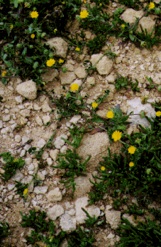Ecological Survey Report
by Peter P. Blanchard III
In June, 1990 and March, 1992 a survey of Yeronisos Island flora and avian fauna was undertaken in order to provide ecological context and guidelines for the excavations. As island ecosystems in general are more fragile and vulnerable to human interference that are their mainland counterparts, an understanding of the ecology of Yeronisos is critical to an environmentally sensitive excavation and to the eventual restoration of all or of a large portion of the island to the natural conditions preceding excavation. The scarcity of islands off the coast of Cyprus underscores the need to proceed carefully with the archaeological investigation and to document conditions both before and after the dig.
Yeronisos Island rises some 21.65 m. above sea level to a level plateau extending some 3.21 acres. It represents an isolated portion of an ancient peninsula, which once extended west from the mainland of Cyprus at Agios Georgios. Now separated from the mainland by approximately 300 m. of shoal water, Yeronisos represents a stack formation, an island created by the undercutting a peninsula by the sea, as frequently encountered on the western coast of the United States.
The close proximity to the mainland has allowed the ready migration of plants and animals and a continuous genetic exchange with organisms on the mainland throughout the island's history. For plants in particular, the short gap between Yeronisos and the mainland can be traversed by water or wind-borne seeds or seeds carried in the digestive tracts or on the feet of birds. Winged insects also would have no problem colonizing the island. Human introduction of animals and plants, both in ancient and in recent times is highly probable. Although mammals were not encountered in this survey, rats, for example, have had a persistent presence on the island and almost certainly arrived on boats.
The fact that Yeronisos Island has been subjected to fire as recently as the early 1980's (the most recent fire representing an effort to eradicate rats) points to the ease of colonization by opportunistic species and sets a baseline for interpreting the present distribution of flora and fauna. The organisms present on Yeronisos at the time of this study either arrived on the island due to dispersion from the mainland following the fire or persisted (in the case of plant species) in fire resistant form, such as seeds, roots or tubers.
A study of plant species on Yeronisos points to successful colonization by opportunistic and vagile species--species that are highly successful in establishing themselves in new and often disturbed environments and that are capable of rapid sexual and asexual reproduction and dispersal. Due to the prevailing dry conditions in the summer, plant species were collected in March, a time when many species are flowering. To facilitate identification, the specimens were placed in a plant press and taken to the Herbarium of the Kew Gardens in London. Kew harbors one of the largest herbaria of Mediterranean plants in the world.
Specimen identification was made in consultation with Desmond Meikle, world authority on the flora of Cyprus. In 95% of the cases, the Yeronisos flora consisted of species commonly encountered on the mainland. The colonizing plants such as Calendula arvensis and Erucaria allepica could have achieved the short translocation from Agios Georgios by many routes, such as those cited above. The presence of fire would favor fire-resistant species which survive through underground corms or tubers or are rapid colonizers following a destructive event. Those species which persist throughout the summer, such as the dominant shrubs, Suaeda fruticosa and Pistacia lentiscus, are able to thrive in xeric conditions due to adaptations such as succulent leaves and thick stems.
Significantly, two species which are quite rare in Cyprus are found on Yeronisos. Cistanche phelypaea is a parasite of Suaeda fruticosa and is present as a leafless flowering vine. Umbilicus horizontalis is a low growing plant on rock surfaces. It is urged that archaeological excavation proceeds carefully with these two particular species in mind, as well as the isolated clumps of cyclamen and poppy.
In summary, following the completion of excavation, it is highly likely that re-establishment of the existing flora, with the exception of the two rare species, will occur naturally. Knowing the plant species which presently occur, however, the Expedition team can supplement or augment plantings, particularly to cover exposed areas of ground that will not be permanently maintained as part of an excavated site. A slow sequential progression of excavation, occurring over a period of summers and utilizing small dig teams, will allow for the recovery of natural vegetation.
It is hoped that other archaeological studies will include an ecological component, as open space and natural areas are put under increasing pressure. Ideally, archaeologists can proceed with both site revelation and reclamation of a natural area in mind. An ecologically sensitive dig can integrate archaeological discoveries with natural setting. The ecology of an archaeological significant area can also provide insights into the dynamics of place which influenced the occupation and utilization of the site in present, historical and prehistoric times.
Fauna
The three nesting bird species on Yeronisos are all commonly found in the Mediterranean region and in Europe: the herring gull (Larus argentinos), which nests on the level and open ground of Yeronisos; high plateau, the jackdaw (Corpus monedula) and the rock dove (Columbia livia), both of which prefer to nest on the sloping sides o the island and in rock crevices. Establishment of the nesting bird species indicates a relatively low rate of human visitation and disturbance. The absence of introduced predators, such as dogs and cats, is critical to the success of any nesting island bird species.
At present, analysis of insect and reptilian faunas have not been attempted. Vagile insect species predictably will recognize disturbed as with ease, given the proximity of the island.



